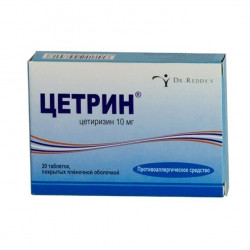



 All payments are encrypted via SSL
All payments are encrypted via SSL
 Full Refund if you haven't received your order
Full Refund if you haven't received your order
/ Cetrine
Cetrine - tablets, coated: 1 table. contains Cetirizine dihydrochloride 10 mg, excipients: lactose; corn starch; Povidone (K-30); Magnesium stearate; hypromellose; macrogol 6000; titanium dioxide; talc; sorbic acid; polysorbate 80; dimethicone; in the package of 20 pieces;
Cetrine - syrup: 1 ml contains 1 mg cetirizine dihydrochloride, excipients: glycerol; sucrose; benzoic acid; disodium edetate; sorbitol solution 70%; sodium citrate; fruit flavor; purified water;
in dark glass bottles of 30 and 60 ml (complete with a dosing cup); in a pack of cardboard 1 set.
Cetrine has antiallergic effect.
Seasonal and perennial allergic rhinitis and conjunctivitis (pruritus, sneezing, rhinorrhea, tearing, conjunctival hyperemia), urticaria (including chronic idiopathic urticaria), pollinosis (hay fever), pruritic allergic dermatosis, angirotrophy, and adrenal grosis;
Hypersensitivity to the components of Cetrine, lactase deficiency, galactosemia, glucose-galactose malabsorption syndrome, pregnancy, breastfeeding period, children under 6 years of age.
With care - at appointment to the patient at advanced age; in patients with chronic renal failure.
Drowsiness, feeling tired, dry mouth, rarely - headache, dizziness, migraine, discomfort in the gastrointestinal tract, allergic reactions (angioedema, skin rash, urticaria, pruritus).
Cetrine is taken orally, regardless of the meal.
Tablets: without chewing, drinking 200 ml of water.
Syrup: washing it down with a little water, preferably in the evening.
Adults or children over 6 years old - 10 mg (1 tab. Or 10 ml of syrup) 1 time per day or 5 mg (1/2 table or 5 ml syrup) 2 times a day.
Children 2-6 years old - 5 mg (5 ml of syrup) 1 time per day or 2.5 mg (2.5 ml syrup) 2 times a day (depending on the severity of the condition or the response).
In the dark place at a temperature of 2-25 ° C.
